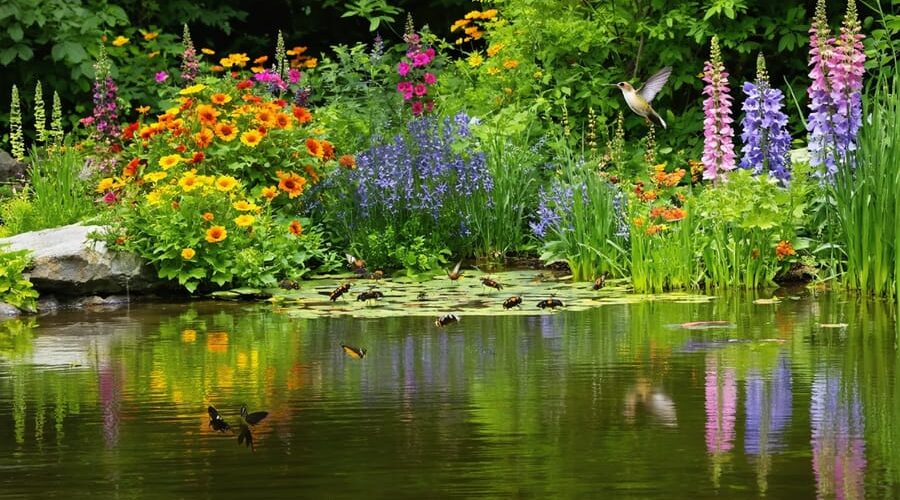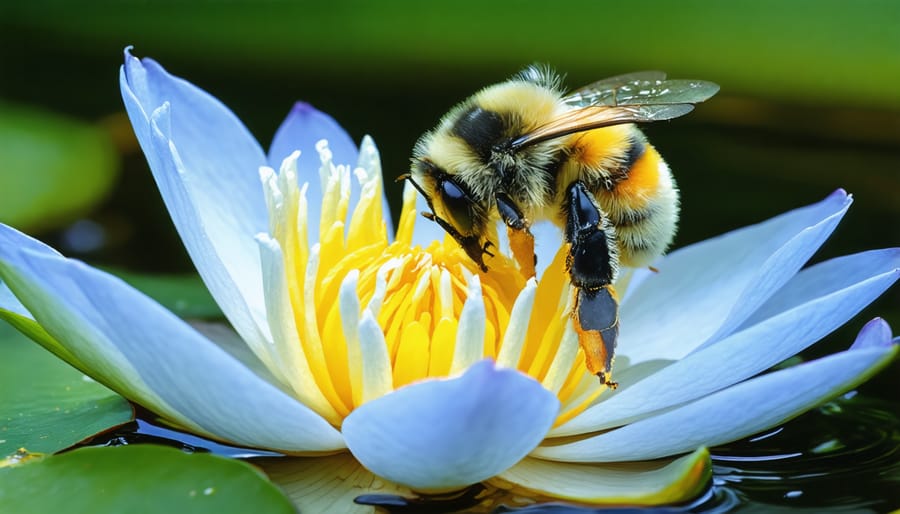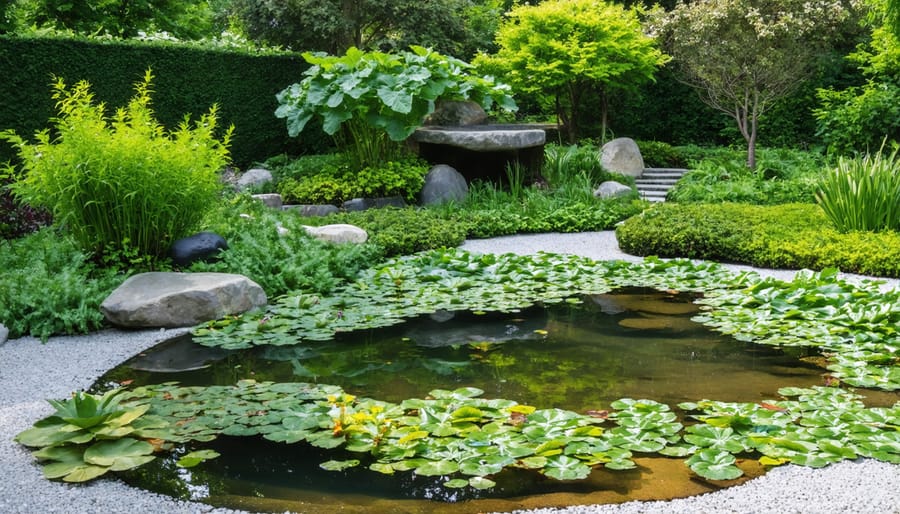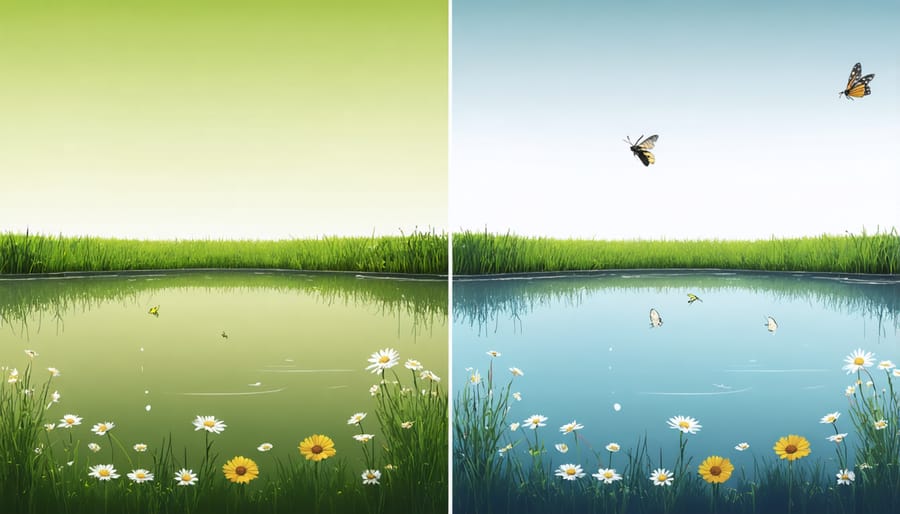
How Pond Pollinators Create a Thriving Water Garden Ecosystem
Transform your backyard pond into a vibrant hub of pollinator activity by cultivating a diverse range of native flowering plants around the water’s edge. Creating a thriving pond ecosystem depends on these essential pollinators – from industrious honeybees to delicate butterflies and nimble hummingbirds. Each species plays a unique role in maintaining the delicate balance of your water garden, contributing to plant reproduction and overall biodiversity. Beyond their practical importance, these fascinating creatures bring life, movement, and color to your outdoor space, creating a dynamic environment that changes with the seasons. By understanding and supporting pollinator diversity, you’re not just enhancing your pond’s beauty – you’re participating in a crucial ecological network that sustains both local wildlife and global food production.
The Key Players in Pond Pollination
Beneficial Insects Around Your Pond
A thriving pond ecosystem attracts a fascinating variety of beneficial insects that play crucial roles in pollination. Honey bees and native bees are frequent visitors, buzzing from water lily to water lily, collecting nectar and transferring pollen as they go. These industrious pollinators are particularly attracted to yellow and white flowering aquatic plants.
Butterflies add both beauty and function to your pond garden, with species like Monarchs and Swallowtails often visiting moisture-loving plants around the water’s edge. They’re especially drawn to purple and pink blooms, making plants like swamp milkweed perfect additions to your pond’s border.
Dragonflies and damselflies, while not primary pollinators, contribute to your pond’s health by controlling mosquito populations while occasionally assisting with pollination. Hover flies, often mistaken for small bees, are excellent pollinators that help maintain the biodiversity of your aquatic garden.
To encourage these helpful insects, maintain a diverse selection of native pond plants that bloom at different times throughout the season. Creating shallow areas with stepping stones or pebbles also provides safe drinking spots for these essential garden helpers.

Birds and Other Vertebrate Pollinators
When it comes to pollination, birds and other vertebrates play a fascinating role in our gardens. Hummingbirds are nature’s tiny helicopters, hovering perfectly still as they sip nectar from tubular flowers. Their long beaks and ability to hover make them especially effective at pollinating deep-throated blooms that bees can’t access.
Besides hummingbirds, other surprising vertebrate pollinators include some species of bats, which are particularly active at night and help pollinate evening-blooming plants. In tropical regions, certain lizards and small mammals like possums and rodents contribute to pollination while feeding on nectar or fruits.
To attract these larger pollinators to your water garden, consider planting cardinal flowers, trumpet honeysuckle, or coral bells around your pond’s edge. These plants not only provide essential nectar but also add beautiful splashes of color to your water feature. Creating perches near your flowering plants gives hummingbirds perfect resting spots between feeding sessions.
Remember that vertebrate pollinators need different accommodations than insects – they require more open spaces for movement and may appreciate shallow water sources for drinking and bathing.
Creating a Pollinator-Friendly Pond Environment
Essential Plants for Pollinator Success
Creating a thriving pollinator habitat starts with choosing the right plants. While many gardeners focus on traditional flower beds, incorporating essential emergent plants and marginal species around your pond can dramatically boost pollinator activity.
For sunny spots, plant Purple Loosestrife and Yellow Flag Iris along the water’s edge. These hardy perennials produce nectar-rich blooms that attract bees and butterflies throughout the growing season. Water Mint not only adds a lovely fragrance but also serves as a magnet for beneficial insects.
Consider adding Cardinal Flower for its striking red blooms that hummingbirds simply can’t resist. Marsh Marigold provides early-season pollen when other plants are just waking up, while Joe-Pye Weed offers late-summer sustenance for migrating butterflies.
Don’t forget about floating plants! Water Lilies create perfect landing pads for dragonflies while producing sweet-scented flowers that attract various pollinators. Pickerelweed doubles as both shelter and food source, with its purple spikes drawing in countless bees and butterflies.
For the best results, plant in groups rather than singles, and ensure you have blooming plants from early spring through late fall. This creates a continuous food source that will keep pollinators coming back to your pond throughout the season.

Pond Design Features That Attract Pollinators
Creating a pollinator-friendly pond involves thoughtful design elements that cater to these beneficial creatures’ needs. Start with gently sloping edges that allow pollinators to safely access the water without drowning. These shallow areas, often called beach entries, provide perfect landing spots for bees and butterflies to drink and rest.
Include flat rocks around the pond’s edge that warm up in the sun, creating ideal basking spots for butterflies and other insects. Position these rocks at different heights to accommodate various species and provide multiple access points to the water.
Plant selection plays a crucial role in your pond’s design. Include native aquatic plants with different blooming periods to ensure year-round food sources. Consider adding water lilies, marsh marigolds, and iris species that provide both nectar and stable landing platforms for pollinators.
Create varying water depths in your pond to support different plant species. Deep areas (2-3 feet) work well for water lilies, while shallow shelves (3-6 inches) are perfect for marginal plants that attract pollinators. Don’t forget to incorporate some vertical elements, such as tall rushes or cattails, which can serve as windbreaks and resting spots.
Remember to avoid using chemicals in your pond, as these can harm pollinators. Instead, maintain water quality naturally through proper plant balance and beneficial bacteria. This creates a safe, inviting environment where pollinators can thrive alongside other pond inhabitants.
Maintaining Pollinator Health Year-Round

Seasonal Support Strategies
Supporting pollinators throughout the year requires different approaches for each season. In spring, leave early-blooming native plants undisturbed and avoid rushing to clean up garden debris, as many beneficial insects overwinter in plant stems and leaf litter. Plant early-flowering bulbs and shrubs to provide crucial food sources when pollinators first emerge.
Summer is prime time for pollinator activity. Maintain a continuous bloom sequence by planting flowers with varied shapes and colors. Keep shallow water sources available, using stones or floating plants as landing spots. Avoid using pesticides during daylight hours when pollinators are most active.
As autumn approaches, leave some seed heads and dried stalks standing – these provide essential food and shelter. Late-blooming plants like asters and goldenrod are vital food sources for pollinators preparing for winter. Consider creating brush piles or insect hotels to offer winter shelter.
During winter, resist the urge to clear everything away. Leave fallen leaves in some areas and maintain dead wood piles, which provide essential hibernation spots for many pollinator species. If you have evergreen shrubs, these offer important winter shelter for overwintering insects.
Year-round, maintain areas of bare soil for ground-nesting bees and avoid using mulch everywhere. Remember that messy gardens are often the most wildlife-friendly, so don’t aim for perfect tidiness in every corner of your outdoor space.
Common Challenges and Solutions
Despite our best efforts to support pollinators, several challenges can affect their populations in our water gardens. One common issue is the use of pesticides and chemicals, which can harm beneficial insects even when targeting unwanted pests. To address this, opt for natural pest control methods and carefully maintain natural pond balance without harsh chemicals.
Climate change and extreme weather events can disrupt pollinator habits and damage their habitats. Creating sheltered areas with dense plantings and providing multiple water sources can help protect these vital creatures during challenging conditions.
Habitat loss is another significant concern, especially in urban areas. Combat this by dedicating more space to pollinator-friendly plants and creating “pollinator corridors” that connect different garden areas. Even small spaces can make a difference when planted thoughtfully.
Competition from invasive species can overwhelm native plants that pollinators depend on. Regular monitoring and removal of invasive plants help maintain a healthy balance. Additionally, timing garden maintenance carefully – such as avoiding heavy pruning during peak flowering periods – ensures continuous food sources for pollinators.
Limited plant diversity can also restrict pollinator populations. Solve this by incorporating various native plants that bloom at different times throughout the season, ensuring year-round support for diverse pollinator species.
As we’ve explored throughout this article, pollinator diversity is essential for maintaining a vibrant and thriving pond ecosystem. When we welcome a variety of pollinators – from busy bees and graceful butterflies to industrious beetles and delicate moths – we’re not just creating a beautiful garden; we’re supporting the intricate web of life that keeps our environment healthy and balanced.
By incorporating different flowering plants, creating safe habitats, and avoiding harmful chemicals, you’re making a real difference in your local ecosystem. Remember, even a small pond area can become a sanctuary for these essential creatures. Each pollinator brings its own unique contribution, whether it’s the long-distance travel of monarch butterflies or the early-morning work of native bees.
The benefits extend far beyond your pond’s edges. A diverse pollinator population ensures better plant reproduction, provides food for birds and other wildlife, and contributes to the overall biodiversity of your neighborhood. Plus, there’s something truly magical about watching these creatures go about their important work while you enjoy your morning coffee by the water.
Ready to get started? Begin with just a few pollinator-friendly plants around your pond. Consider adding some native flowering species, creating a small bee house, or setting up a butterfly puddling station. Every small step you take helps create a more sustainable and wildlife-friendly environment.
Remember, you’re not just building a pond – you’re creating a living ecosystem that benefits your local environment and brings joy to everyone who visits. Your efforts in supporting pollinator diversity make a real difference in preserving these vital species for future generations.
